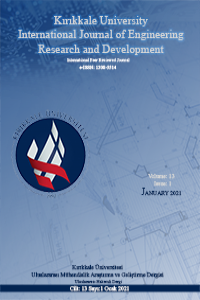Abstract
Electric lighting is one of the main factors consuming energy in commercial buildings. Use of sunlight has become crucial for indoor lighting to save energy. So, it is necessary to use control algorithms in order to meet indoor lighting conditions and keep them at a certain level using sunlight. Energy saving by sunlight contribution has raised specialists’ interest in this field. By the application of lighting control system there will be decline in annual energy consumption. And this will help to increase the efficiency and satisfaction of employees by using artificial light and sunlight. In this study, a fuzzy-logic controller was designed using sunlight and regarding lighting comfort. Motion sensors were installed in tables in an office room created in a simulation environment. Lighting system sets itself automatically detecting the movement of users and also lets them to choose the lighting level for their lighting comfort. Result of the simulation shows that using comfort lighting saves much energy compared to uncontrolled lighting.
References
- Aprea, C., Mastrullo, R., & Renno, C. (2006). Experimental analysis of the scroll compressor performances varying its speed. Applied Thermal Engineering, 26(10), 983–992. https://doi.org/10.1016/J.APPLTHERMALENG.2005.10.023
- Byun, J., Hong, I., Lee, B., & Park, S. (2013). Intelligent Household LED Lighting System Considering Energy Efficiency and User Satisfaction. In IEEE Transactions on Consumer Electronics (Vol. 59). Retrieved from http://pgembeddedsystems.com/securelogin/upload/project/IEEE/33/PGEMB0030/Intelligent Household LED Lighting System.pdf
- Demirtaş, M., & Çelik, K. (n.d.). Sokak Aydınlatması için Akıllı LED Aydınlatma Sistemi Tasarımı ve Verimlilik Analizi. Emo.Org.Tr.
- Kristl, Ž., Košir, M., Trobec Lah, M., & Krainer, A. (2008). Fuzzy control system for thermal and visual comfort in building. Renewable Energy, 33(4), 694–702. https://doi.org/10.1016/j.renene.2007.03.020
- Mendel, J. M. (1995). Fuzzy Logic Systems for Engineering: A Tutorial. Proceedings of the IEEE, 83(3), 345–377. https://doi.org/10.1109/5.364485
- Oh, M. H., Lee, K. H., & Yoon, J. H. (2012). Automated control strategies of inside slat-type blind considering visual comfort and building energy performance. Energy and Buildings, 55, 728–737. https://doi.org/10.1016/j.enbuild.2012.09.019
- Resource Pages | WBDG - Whole Building Design Guide. (n.d.). Retrieved June 24, 2019, from https://www.wbdg.org/resources/energy-efficient-lighting.
- Ross, T. J. (2010). Fuzzy Logic with Engineering Applications: Third Edition. https://doi.org/10.1002/9781119994374
- Ryckaert, W. R., Smet, K. A. G., Roelandts, I. A. A., Gils, M. Van, & Hanselaer, P. (2012). Linear LED tubes versus fluorescent lamps: An evaluation. Energy & Buildings, 49, 429–436. https://doi.org/10.1016/j.enbuild.2012.02.042
- Şahin, M., Büyüktümtürk, F., & Oğuz, Y. (2013). Yapay Sinir Ağları ile Aydınlık Kalitesi Kontrolü. Afyon Kocatepe Üniversitesi Fen Ve Mühendislik Bilimleri Dergisi, 13(2), 1–10. Retrieved from https://dergipark.org.tr/akufemubid/issue/1600/19877
- Şener Yılmaz, F. (n.d.). Güneş Kontrolü Tasarımının Görsel Konfor ve Günışığı Performansına Etkisi: Ofis Binaları. Retrieved from http://www.adjournal.net/articles/44/444.pdf
- Yun, G. Y., & Kim, H. (2012). Effects of occupancy and lighting use patterns on lighting energy consumption. Energy and Buildings, 46, 152–158. https://doi.org/10.1016/J.ENBUILD.2011.10.034
Abstract
Ticari binalarda elektrik aydınlatması en çok enerji harcayan temel unsurlardan biridir. Binaların iç aydınlatmasında enerji tasarrufu yapabilmek için güneş ışığından yararlanmak önemli bir hale gelmiştir. Bu sebeple iç mekân aydınlatma koşullarını yeterli bir seviyede tutmaya devam ederken gün ışığından faydalanarak iç mekân aydınlatma koşullarını yakalamak ve bunun için gerekli kontrol algoritmaları kullanmak gerekir. Gün ışığı aydınlatmasıyla enerjiden önemli ölçüde tasarruf edilmesi uzmanların bu alana olan ilgisini arttırmıştır. Aydınlatmada kontrol sisteminin uygulanmasıyla yıllık enerji tüketiminde azalma olacaktır. Bu aynı zamanda, yapay aydınlatma ve gün ışığından yararlanarak, çalışanların çalışma verimliliğini ve memnuniyetini arttırmasına yardımcı olur. Bu makalede gün ışığı aydınlatmasından faydalanarak ve aydınlatma konforu göz önüne alınarak bir bulanık mantık denetleyicisi tasarlanmıştır. Simülasyon ortamında hazırlanan bir ofis dairesinde masalara hareket sensörleri yerleştirilmiştir. Kullanıcıların hareketlerine göre aydınlatma sistemi otomatik olarak ayarlanır ve kullanıcıların kendi aydınlatma konforu tercihlerine göre seçim yapmalarına izin verilir. Simülasyon sonuçları kontrolsüz aydınlatma sistemi ile konforlu aydınlatma kullanılarak enerjiden önemli ölçüde tasarruf edilebileceğini göstermektedir.
References
- Aprea, C., Mastrullo, R., & Renno, C. (2006). Experimental analysis of the scroll compressor performances varying its speed. Applied Thermal Engineering, 26(10), 983–992. https://doi.org/10.1016/J.APPLTHERMALENG.2005.10.023
- Byun, J., Hong, I., Lee, B., & Park, S. (2013). Intelligent Household LED Lighting System Considering Energy Efficiency and User Satisfaction. In IEEE Transactions on Consumer Electronics (Vol. 59). Retrieved from http://pgembeddedsystems.com/securelogin/upload/project/IEEE/33/PGEMB0030/Intelligent Household LED Lighting System.pdf
- Demirtaş, M., & Çelik, K. (n.d.). Sokak Aydınlatması için Akıllı LED Aydınlatma Sistemi Tasarımı ve Verimlilik Analizi. Emo.Org.Tr.
- Kristl, Ž., Košir, M., Trobec Lah, M., & Krainer, A. (2008). Fuzzy control system for thermal and visual comfort in building. Renewable Energy, 33(4), 694–702. https://doi.org/10.1016/j.renene.2007.03.020
- Mendel, J. M. (1995). Fuzzy Logic Systems for Engineering: A Tutorial. Proceedings of the IEEE, 83(3), 345–377. https://doi.org/10.1109/5.364485
- Oh, M. H., Lee, K. H., & Yoon, J. H. (2012). Automated control strategies of inside slat-type blind considering visual comfort and building energy performance. Energy and Buildings, 55, 728–737. https://doi.org/10.1016/j.enbuild.2012.09.019
- Resource Pages | WBDG - Whole Building Design Guide. (n.d.). Retrieved June 24, 2019, from https://www.wbdg.org/resources/energy-efficient-lighting.
- Ross, T. J. (2010). Fuzzy Logic with Engineering Applications: Third Edition. https://doi.org/10.1002/9781119994374
- Ryckaert, W. R., Smet, K. A. G., Roelandts, I. A. A., Gils, M. Van, & Hanselaer, P. (2012). Linear LED tubes versus fluorescent lamps: An evaluation. Energy & Buildings, 49, 429–436. https://doi.org/10.1016/j.enbuild.2012.02.042
- Şahin, M., Büyüktümtürk, F., & Oğuz, Y. (2013). Yapay Sinir Ağları ile Aydınlık Kalitesi Kontrolü. Afyon Kocatepe Üniversitesi Fen Ve Mühendislik Bilimleri Dergisi, 13(2), 1–10. Retrieved from https://dergipark.org.tr/akufemubid/issue/1600/19877
- Şener Yılmaz, F. (n.d.). Güneş Kontrolü Tasarımının Görsel Konfor ve Günışığı Performansına Etkisi: Ofis Binaları. Retrieved from http://www.adjournal.net/articles/44/444.pdf
- Yun, G. Y., & Kim, H. (2012). Effects of occupancy and lighting use patterns on lighting energy consumption. Energy and Buildings, 46, 152–158. https://doi.org/10.1016/J.ENBUILD.2011.10.034
Details
| Primary Language | Turkish |
|---|---|
| Subjects | Engineering |
| Journal Section | Articles |
| Authors | |
| Publication Date | January 18, 2021 |
| Submission Date | December 26, 2019 |
| Published in Issue | Year 2021 Volume: 13 Issue: 1 |
Cited By
E27 Duya Sahip Lambaların Karşılaştırması için Test Düzeneği Hazırlanması
Mehmet Akif Ersoy Üniversitesi Fen Bilimleri Enstitüsü Dergisi
Sertaç GÖRGÜLÜ
https://doi.org/10.29048/makufebed.929436
All Rights Reserved. Kırıkkale University, Faculty of Engineering and Natural Science.


